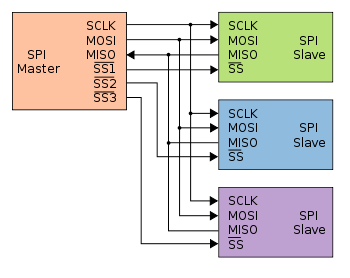
Serial Peripheral Interface (SPI) is an interface bus. It helps transfer data between microcontrollers while keeping them in sync and ensuring continuous connectivity. It is also called as a communication bus between master and slaves. The master is the main hub which has information and data stored in it. This when transmitted to slaves or recipients is done through the SPI.
Electronic devices work and communicate in the same way as human beings do. Humans send messages (signals) to other human beings. They wait for them to reply and then start working. Likewise, electronic devices send circuits and microcontrollers within them signals. These signals awaken the system and help fetch data. This data is then used in further work. A form of this data transfer and communication is called SPI.
SPI uses a separate apparatus to help in this data transfer between micro-controllers or master and slave devices. An SPI generally has a clock, slave selects, multiple slaves and data lines. Alongside there are various other instruments too, that facilitate in this data flow. It is also called a synchronous data bus. This is because it ensures that the clock and data are oscillating in the perfect momentum and transporting information where needed. It is also called a synchronous collection as devices share the signal and synchronizing in transmitting data.
An SPI starts working when the clock signals start generating the data from the master to the slave. The clock here represents that device that the user hits when calling for data. This clock moves at a speed, up or down. The speed of data transfer is determined by the signal that the clock is able to generate. The signal when transmitted initiates the collection of data.
SPI helps in one way communication by extracting or getting data. The way this works is through the master and slave components as mentioned above. The master component helps generate the clock signal. Through the clock, data is sent from the master to the slave. This is only one way transmission of information. However, sometimes the slave may want to repay the master and send along some information too. This is done through a separate signal and channel. This means from master to slave one channel is used and from slave to master one but another channel is used. This helps prevent overlapping or distortion of information.
However, the master has the capability to generate the clock signal. Therefore, the master should be informed beforehand if slave will send a signal, what the signal will be and how much data it will carry. There is also a concern with master sending signals to slaves. Selecting the right slave. Since there may be many slaves in the SPI, selecting the correct slave for this information transfer is important. For this there exists a slave select (SS) line. Before sending data SS activates the slave so that it is prepared to receive information and dispatch.
A major benefit of SPI is that information is transferred without any hassle. There are no breaks or pauses in this information transfer. Moreover, data worth a huge amount can be easily sent and taken over an SPI. There is no limit to the amount of data that can be transferred. Moreover, since SPI supports multiple slaves, data can be gathered in a lesser amount of time and in a higher frequency.
Since SPI requires high speed signals data should be sent over shorter distances only through it. If a long distance needs to be covered, then one must lower the clock speed and then send data. For an SPI to work better or give maximum efficiency, one can even use logic analyzer. A logic analyzer is a smart tool which will assist and facilitate the SPI in information gathering.
FIRST
I simply want to mention I am just beginner to weblog and really liked you’re blog site. Probably I’m going to bookmark your website . You definitely have incredible article content. With thanks for sharing with us your blog site.